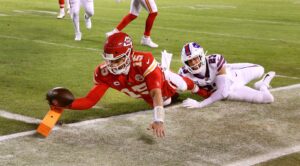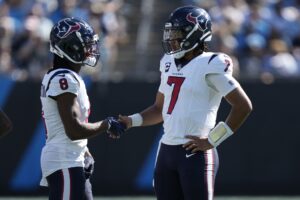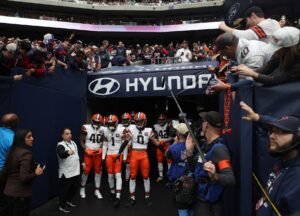One week into the season, and the Kansas City Chiefs dominated the New England Patriots with immaculate statistics and execution. Second week in, and the Chiefs trajectory to dominance in the AFC West continued. In beating the Philadelphia Eagles, the Chiefs executed with a will to win on offense, and the intensity of a powerful defense. For three quarters, the game was essentially a one-to-one matchup with both defenses executing. However, when it mattered most, the Chiefs special teams executed, Kareem Hunt powered behind a composed offensive line, and Alex Smith managed to mentally win. The Chiefs stats broke the mold of an offense inept to overcome difficulties and found a late game surge to secure a week two victory.
Kansas City Chiefs Stats and Charts – Defending Arrowhead
Chaos Theory
Chaos theory is all about finding those points in the game that dramatically change momentum and influence on the outcome. While last week Eric Berry’s play swung momentum toward the Chiefs side, the most standard type of plays that influence the chaos a team endures is the tangentially overlooked special teams unit. Fortunately for the Chiefs, they possess a historically consistent special teams unit behind coach Dave Toub; and the system looks to be successful in 2017.
Twice, the Chiefs special team unit made dramatic plays that may have won them the game. The first came when long snapper James Winchester personified a missile and nailed Darren Sproles on a punt return with one and a half minutes left in the second quarter. Up until this point, both teams were equally in control of the chaos model; neither team had broken momentum. The Sproles fumble was the first point in the game that gave the Chiefs an advantage.
However, chaos patterns can also be swung back toward the middle thanks to execution at opportune times. Mathematically, the Eagles had the most opportune time to score and retake momentum as they got the ball back. Right before the half, Carson Wentz hit Zach Ertz on a tipped ball reception for 53 yards. Chaos was shortly in control for the Eagles, but that would soon be swung back toward the Chiefs.
Jake Elliott lined up for a 30-yard field goal but missed wide left after the Chiefs called a time out. This play, however, was a mix of the pressure from a great special teams unit and the power of the crowd in Arrowhead Stadium.
The Chiefs truly won the game and took momentum on Travis Kelce’s fourth quarter touchdown. However, those two plays right before the half were the most momentous scenarios that set up the Chiefs long term momentum. Had the Eagles scored before half and the Chiefs not forced a fumble, the game plan and trajectory of the second half would have looked different.
A team cannot win the game in the second quarter, but the set-up for the fourth quarter victory can certainly be accomplished early in the game.
Defensive Prowess
The Chiefs defense, for a second straight week, gave the Chiefs offense the chance to win the game. With six sacks on Wentz, the pass rush came alive and prevented their secondary from getting exposed. Without Berry in the secondary, the Chiefs had extra pressure schematically on their secondary unit. The pass rush and rush defense never gave the Eagles a chance to execute their game plan.
Pressure is key to throwing off the Eagles scheme. In 2016 when Wentz was sacked three or more times, he did not win. Occurring five times throughout 2016, the Eagles offensive line is innately connected to the success of the young Wentz.
The offensive line being good in wins may seem like an obvious observation. However, consider this. When the Eagles lose and get pressured, their run game struggles. Due to the aerial attack the Eagles employ, the pass game gets the Eagles in position to run. In the Eagles losses last year, they only ran for seven touchdowns, with four coming in two games.
The Chiefs defense did exactly what they ought to have done – shut down the will to run, force the pressure to pass, and then get after Wentz. The plan may seem obvious, but the way it was done is truly impressive. Wentz’s 83 rating on Sunday is usually enough to get the Eagles a win (5-2 when above 82).
And just to cement how much pressure helps, the Chiefs gave up only three explosive passes, one of which was the Ertz long reception that resulted from an unfortunate tip. Facing a team that looks to run after the pass, disallowing them from getting into the red zone was paramount to beat the Eagles.
Offensive Efficiency
The Chiefs stats showed an incredibly efficient offense, albeit a struggling offense through the first three quarters. However, in the NFL, a tightly contested matchup for three quarters is not out of the norm – teams are separated by who wins in the fourth quarter, and that is exactly what Smith did.
Despite getting sacked four times, and pressured an innumerable amount of other instances, Smith went 21 of 28 for 251 yards. He found the explosive plays and opportunities when they came, and avoided making dangerous mistakes. Smith’s stats through two weeks show a quarterback that is intelligent and methodically dangerous.
He only needed two explosive passes to secure the win; both passes to Kelce and Chris Conley came in crucial moments. But more importantly, those explosive passes set up scoring and the offense found rhythm to finish. An interesting trajectory to watch will be if Smith completes more explosive passes, or if the offense is more refined and finishing in scoring after explosive passes.
On 328 completions last year, Smith completed 49 of those for explosive passes, or 15 percent. In 2017 Smith has completed five passes for explosive plays on 49 completions, or a ten percent sample through two short weeks. However, the question is the nature of these passes; is Smith throwing more intrinsic explosive passes compared to players turning short yard gains into long passes?
Smith put the Chiefs in the position to win; his ability to evade a sack late in the game allowed the Chiefs to secure a score. The offensive line must step up their play to allow Smith more time, more often. Yet, their run blocking was incredible when it came to the most important times.
Behind the offensive line, the Chiefs rushed 19 times for 112 yards. However, 53 of those yards came on one play when Hunt had a massive hole to run through. In the red zone, the Chiefs are averaging 4.2 yards per carry and have an 80 percent run success rate. Hence, if the Chiefs get to the red zone, they have not been settling for field goals, but are instead putting the ball in the end zone – one of the most important implications of success.
To summarize the Chiefs powerful running game through two weeks, Smith has been connecting with receivers on his standard short yard routes to put the Chiefs in manageable third downs. Andy Reid has negated plays that put the Chiefs in long third-down plays that demand explosive plays to win.
On third down, the Chiefs have 100 percent rushing success. Granted, that is on two attempts. However, the Chiefs on first down are seeing 57 percent rushing success, averaging ten yards per carry.
The Chiefs stats are showing they have an offensive scheme that intrinsically relies on what Smith, Hunt, Kelce, et al. are good at. Intertwining the athleticism of Tyreek Hill and Hunt have created a new, creative approach to spice up the Chiefs most successful attributes.
Main Image:






